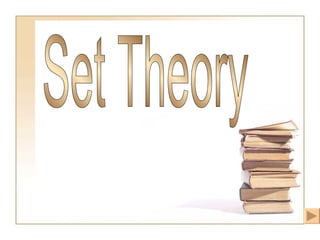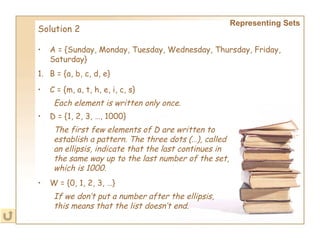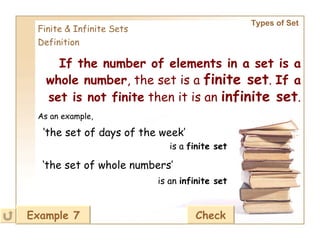SET THEORY
- 1. Set Theory
- 2. BASIC CONCEPTS OF SETS Content Define a set Represent a set Define the number of elements of a set Practice Problems 1 Compare sets Recognize different types of set Practice Problems 2 Define the subsets of a set Review Exercises 1 OPERATIONS ON SETS Determine the union of two or more sets Practice Problems 3 Determine the intersection of two or more sets Practice Problems 4 Determine the complement of a set Determine the difference of two sets Practice Problems 5 Review Exercises 2 Lesson is over
- 3. Defining a Set Definition A collection of well-defined objects is called a set . ‘ the set of former Nobel Prize winners’ is a well-defined set ‘ the set of tall students in our university’ is not a well-defined set For example, It’s interesting Note
- 4. Note Sets must be well-defined. A set is well-defined if we can tell whether a particular object is an element of that set.
- 5. Definition Each object in a set is called an element or a member of the set. Defining a Set A, B, C, … a, b, c, … Sets notation: Elements Notation: Note For example, A = {a, b, c, d} b A ‘ b is an element of set A’ or ‘b is in A’ f A ‘ f is not an element of set A’ or ‘f is not in A’ Example 1 Check
- 6. The order of elements in a set is not important. Note Each element of the set is written only once.
- 7. George Cantor (1845-1918) George Cantor was born March 3, 1845 in St. Petersburg, Russia and died January 6, 1918 in Halle, Germany. Cantor was the first mathematician who defined the basic ideas of set theory. Using ingenious methods, he proved remarkable things about infinite sets.
- 8. Defining a Set Solution 1 h B h. 1 B g. 3 B f. 10 B e. 0 B d. B c. B b. a B a.
- 9. Representing Sets The List Method The Defining-Property Method The Venn Diagram Method It’s interesting
- 10. Representing Sets The List Method For instance, A = { , , , } Example 2 C = {I, You, He, She, We, They} Check
- 11. Representing Sets Solution 2 A = {Sunday, Monday, Tuesday, Wednesday, Thursday, Friday, Saturday} B = {a, b, c, d, e} C = {m, a, t, h, e, i, c, s} Each element is written only once. D = {1, 2, 3, …, 1000} The first few elements of D are written to establish a pattern. The three dots (…), called an ellipsis, indicate that the last continues in the same way up to the last number of the set, which is 1000. W = {0, 1, 2, 3, …} If we don’t put a number after the ellipsis, this means that the list doesn’t end.
- 12. Representing Sets The Defining-Property Method For example, B={x| x is a season of the year} When we use the defining-property method we can use the symbol ‘:’ instead of ‘|’. Example 3 Check B is the set of all x such that x is a season of the year Note
- 13. Representing Sets Solution 3 D = {z| z is a blood type} A = {the days of the weekend}, or A = {x| x is a day of the weekend} B = {x| x is a season of the year} C = {y| y is a whole number less than 25 & divisible by 3}
- 14. Representing Sets The Venn Diagram Method . c As an example, . b . a A Each element of the set is represented by a point inside the closed shape. Example 4 Check Note
- 15. John Venn (1834-1923) John Venn was born August 4, 1834 in Hull, Yorkshire, England and died April 4, 1923 in Cambridge, England. Venn diagrams (a diagrammatic way of representing sets & their relationships) were introduced in 1880 by John Venn.
- 16. Representing Sets Solution 4 A . 9 . 7 . 5 . 3 . 1 a. b. . July . June . January . 5 C . 0 . 10 . 20 . 15 c.
- 17. Number of Elements of a Set Definition Denotation: The number of elements in a set A is called the cardinal number of the set A. n(A) Example 5 Check
- 18. Number of Elements of a Set Solution 5 n(A) = 9 {a, b} & {e, f} are elements of set B, therefore n(B) = 5 E = {M, A, T, H, E, I, C, S} so n(E) = 8 Nobody lives on the sun, so n(P) = 0
- 19. Practice Problems 1 f A A = { , , , } . c . b . a A n(A) B={x| x is a season of the year}
- 20. Comparing Sets Equivalent Sets Equal Sets Note
- 21. Comparing Sets Definition Two sets are equivalent if they have the same number of elements. If A & B are equivalent A B ‘ set A is equivalent to set B’ For example , A = {a, b, c, d} & B = {1, 2, 3, 4} n(A) = n(B) = 4 so A B Equivalent Sets
- 22. Comparing Sets Definition Two sets are equal if they have exactly the same elements. If A & B are equal A = B ‘ set A is equal to set B’ Example 6 Check Equal Sets
- 23. A & B contain exactly the same elements, therefore they are equal. Solution 6 Comparing Sets Therefore, we can write A = B.
- 24. Note If A is equal to B, then A is also equivalent to B. A = B A B If A is equivalent to B, then A might not be equal to B. However, A B A = B
- 25. Types of Set Empty (Null) Set The Universal Set Finite & Infinite Sets
- 26. Types of Set Empty (Null) Set Definition The set that contains no element is called the empty set or the null set . Denotation: or { } As an example, A = {x| x is a month containing 32 days} So A = & n( ) = 0
- 27. Types of Set The Universal Set Definition The Universal set is the set of all elements under consideration in a given discussion. Denotation: U For instance, U = {a, b, c, d, e, f, g, h, I, j} A = {a, b, c} B = {c, d, e} C = {f, g, h}
- 28. Types of Set Finite & Infinite Sets Definition If the number of elements in a set is a whole number , the set is a finite set . If a set is not finite then it is an infinite set . Example 7 Check As an example, ‘ the set of days of the week’ is a finite set ‘ the set of whole numbers’ is an infinite set
- 29. Solution 7 Types of Set A is a finite set B is a finite set E is a finite set The set of whole numbers is an infinite set The set of integers is an infinite set F = & n( ) = 0, so F is a finite set
- 30. Practice Problems 2 A = B A B A = B n( ) = 0 U = {a, b, c, d, e, f, g, h, I, j} Z = {… -3, -2, -1, 0, 1, 2, 3, …}
- 31. Subsets Definition Set A is a subset of set B if every element of A is also an element of B. If A B ‘ A is a subset of B’, or ‘A is contained in B’ If B A ‘ B is a super set of A’, or ‘B contains A’ B . 2 . 4 . 6 U . 8 . 7 A . 5 . 3 . 1 A B B U A U Example 8 Check
- 32. Subsets Solution 8 True, because every element of set B is also an element of A. False. 3 A and 5 A, but 7 A, so C A. False. There is no common element in C and B. B . 2 . 1 . 3 . 5 C . 7 A . 4
- 33. Subsets Properties Every set is a subset of itself. (A A) The empty set is a subset of any set. ( A) If A B and B A then A = B. If A B, B C then A C. (Transitive) The number of subsets of a set with n elements is 2 n .
- 34. REVIEW EXERCISES 1 S = { , , , } A = B A B . c . b . a D n( ) = 0 f A
- 35. Union of Sets Definition The union of sets A & B is the set of all elements which belong to A or to B (or to both). We write A B & say ‘ A union B’ Union of sets A and B A B = {a, b, c, d, e, f, g, h}. If A = {a, b, c, d, e} & B = {a, c, f, g, h}, then Example 9 Check Note
- 36. Note If a A B then a A or a B. Each element must be written only once in the union of sets.
- 37. Solution 9 Union of Sets A B = {a, b, c, d, e, f} {a, d, g, h} = {a, b, c, d, e, f, g, h} C D = {1, 3, 5, 7, 9} {1, 3, 5} = {1, 3, 5, 7, 9}
- 38. Union of Sets Properties of the Union Let A, B, C be three sets, then the following statements are true: (idempotent law) A A = A (commutative property) A B = B A A (B C) = (A B) C (associative property) A = A (identity law) A U = U Example 10 Check
- 39. Solution 10 Union of Sets . We can easily see that A (B C) = (A B) C = {a, b, c, d, e, f, g}. A A = {a, b, c, d} {a, b, c, d} = {a, b, c, d} So, A A = A. A = {a, b, c, d} { } = {a, b, c, d} So, A = A. A B = {a, b, c, d} {c, d, e, f} = {a, b, c, d, e, f} B A = {c, d, e, f} {a, b, c, d} = {a, b, c, d, e, f} So, A B = B A. B C = {c, d, e, f} {a, d, e, g} = {a, c, d, e, f, g} A (B C) = {a, b, c, d} {a, c, d, e, f, g} = {a, b, c, d, e, f, g} A B = {a, b, c, d} {c, d, e, f} = {a, b, c, d, e, f} (A B) C = {a, b, c, d, e, f} {a, d, e, g} = {a, b, c, d, e, f, g}
- 40. Practice Problems 3 A B = B A A B n( ) = 0 U = {a, b, c, d, e, f, g, h, I, j} Z = {… -3, -2, -1, 0, 1, 2, 3, …}
- 41. Intersection of Sets Definition The intersection of two sets A & B is the set of all elements that are in both A & B . Note We write A B & say ‘ A intersection B’ Example 11 Check
- 42. Note If a A B then a A & a B.
- 43. Solution 11 Intersection of Sets A B = {a, b, c, d, e} {c, d, f, g} = {c, d} C D = {1, 2, 3, 4, 5} {1, 3, 5} = {1, 3, 5} = D E F = {m, n, o} {p, r, s, t} =
- 44. Intersection of Sets Properties of the Intersection Let A, B, & C be three sets, then the following statements are true: A A = A (idempotent law) A B = B A (commutative property) A (B C) = (A B) C (associative property) A = (identity law) A U = A Example 12 Check
- 45. Solution 12 Intersection of Sets A A = {1, 2, 3, 4} {1, 2, 3, 4} = {1, 2, 3, 4} = A A = {1, 2, 3, 4} { } = A B = {1, 2, 3, 4} {2, 3, 5, 6} = {2, 3} B A = {2, 3, 5, 6} {1, 2, 3, 4} = {2, 3} So, A B = B A (A B) C = {2, 3} {3, 4, 5, 7} = {3} A (B C) = {1, 2, 3, 4} {2, 3} = {3} So, (A B) C = A (B C)
- 46. Intersection of Sets Rule Distributive Laws For any three sets A, B, & C, the following statements are true: is distributive over from the left & the right. A (B C) = (A B) (A C) (A B) C = (A C) (B C) is distributive over from the left & the right. A (B C) = (A B) (A C) (A B) C = (A C) (B C) Example 13 Check
- 47. Solution 13 Distributive Laws B C = {b, d, e, f} {a, b, e, g} = {a, b, d, e, f, g} A (B C) = {a, b, c, d} {a, b, d, e, f, g} = {a, b, d} B C A (B C) A B = {a, b, c, d} {b, d, e, f} = {b, d} A C = {a, b, c, d} {a, b, e, g} = {a, b} (A B) (A C) = {b, d} {a, b} = {a, b, d} A B A C (A B) (A C) = A (B C) = (A B) (A C) This example is left as an exercise for you.
- 48. Practice Problems 4 A (B C) A B = B A A B n( ) = 0
- 49. Complement of a Set Definition The set of elements of U which are not elements of set A is called the complement of A. A c or A’ ‘ the complement of set A’
- 50. Let U be a universal set & A U. Complement of a Set Properties A A’ = U A A’ = U’ = (A’)’ = A ’ = U Example 14 Check
- 51. Solution 14 Complement of a Set A’ = {4, 5, 8, b} A A’ = {a, 3, 7, 9} {4, 5, 8, b} = {3, 4, 5, 7, 8, 9, a, b} = U A A’ = {a, 3, 7, 9} {4, 5, 8, b} = A’ = {4, 5, 8, b} (A’)’ = {a, 3, 7, 9} = A
- 52. Difference of Two Sets Definition The set of elements that are in A but not in B is called the difference of sets A and B . Note A-B or A ‘ A difference B ’ Example 15 Check
- 53. Note
- 54. A – B = {1, 2} Solution 15 Difference of Two Sets B – A = {5, 6, 7} A – A = A – = {1, 2, 3, 4} = A A B’ = {1, 2, 3, 4} {1, 2, a, b} = {1, 2} = A – B (A – B) (A B) = {1, 2} {3, 4} = {1, 2, 3, 4} = A (A – B) (B – A) = {1, 2} {5, 6, 7} =
- 55. Difference of Two Sets Properties A – B B – A A – = A (A – B) (B – A) = A – A = A – B = A B’ If A B then A – B = De Morgan’s Laws If A and B are two sets, then (A B)’ = A’ B’ and (A B)’ = A’ B’ . Example 16 Check
- 56. Solution 16 Difference of Two Sets A – B’ = {1, 2, 3} A – (B C) = {a, b, c, 1, 2, 3} – {1, 2, 3, 4, 5, 6} = {a, b, c} (A B)’ = {1, 2, 3}’ = {a, b, c, 4, 5, 6, 7, 8, 9} A’ B’ = {4, 5, 6, 7, 8, 9} {a, b, c, 6, 7, 8, 9} = {a, b, c, 4, 5, 6, 7, 8, 9} So, (A B)’ = A’ B’ (A B)’ = {a, b, c, 1, 2, 3, 4, 5}’ = {6, 7, 8, 9} A’ B’ = {4, 5, 6, 7, 8, 9} {a, b, c, 6, 7, 8, 9} = {6, 7, 8, 9} So, (A B)’ = A’ B’ (A B)’ C’ = {a, b, c, 4, 5, 6, 7, 8, 9} {a, b, c, 1, 5, 7, 8, 9} = {a, b, c, 1, 4, 5, 6, 7, 8, 9}
- 57. Practice Problems 5 A B = B A A B n( ) = 0 A (B C)
- 58. REVIEW EXERCISES 2 n( ) = 0 A (B C) A A’ = U A – A =

























































